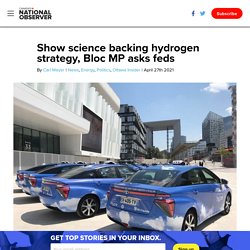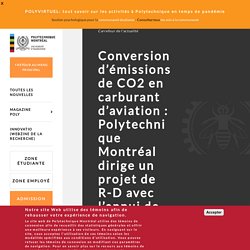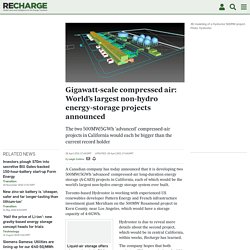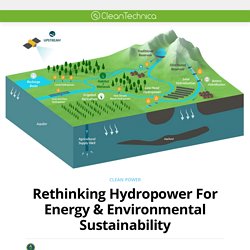

Show science backing hydrogen strategy, Bloc MP asks feds. A Bloc Québécois MP asked federal government officials Monday if they could cite any scientific papers backing Canada’s plan to rely on the oil and gas industry for help in growing a market for hydrogen fuel.

Bloc natural resources critic Mario Simard made the comments during a meeting of a House of Commons committee that is studying the low-carbon and renewable fuels industry in Canada. “What scientific study are you using as your justification to say that hydrogen is a viable way to transition to a green economy?” Simard asked Mollie Johnson, Natural Resources Canada assistant deputy minister for the low-carbon energy sector. Get top stories in your inbox. Our award-winning journalists bring you the news that impacts you, Canada, and the world. Conversion d’émissions de CO2 en carburant d’aviation : Polytechnique Montréal dirige un projet de R-D avec l’appui de Québec. (Photo : Adobe Stock) Le groupe de recherche Électrification des procédés intensifiés et catalyse (EPIC) de Polytechnique, dirigé par la professeure agrégée Daria Camilla Boffito, s’associe au consortium SAF+, à CCG Climat et au Centre d'études des procédés chimiques du Québec (CÉPROCQ) du Collège de Maisonneuve pour la tenue du projet « Développement et optimisation d'un design conceptuel d'usine de conversion de CO2 en carburants propres d'aviation ».

Ce programme de R-D positionnera le Québec à l'avant-garde des technologies d'utilisation du carbone dans les domaines de l’aviation et des carburants. Ce projet de recherche est soutenu par le ministère de l'Économie et de l'Innovation et le ministère de l'Environnement et de la Lutte contre les changements climatiques du Québec, par l’entremise du pôle de recherche et d’innovation PRIMA Québec. Le gouvernement du Québec contribue 140 000 dollars au projet qui est évalué à plus de 840 000 dollars.
Une collaboration à fort potentiel. L'Aquilon - L'hebdomadaire francophone du Grand Nord canadien. Les deux éoliennes seraient construites à l’est des collectivités jumelles de Kuujjuarapik et Whapmagoostui dans le delta de la Grande Rivière de la Baleine.

Dans le Nord-du-Québec, un projet d’éoliennes par et pour les Autochtones promet de réduire les gaz à effet de serre tout en faisant collaborer deux communautés parfois distantes. Dans la partie québécoise de la baie d’Hudson, où commence le territoire des Inuits et finit celui des Cris, les deux peuples participent à un projet d’éoliennes qui leur permettrait de diminuer de près de moitié l’utilisation du diésel pour la production d’électricité. « C’est l’équivalent de 4000 automobiles de moins », de dire Jean Schiettekatte, vice-président à l’énergie renouvelable de Yab Management, la firme gestionnaire du projet, impliquée dans de nombreuses constructions au Nunavut, dont celle de l’hôpital d’Iqaluit. 'Green hydrogen will be cost-competitive with grey H2 by 2030 — without a carbon price' The cost of green hydrogen is expected to see “dramatic cost reductions” this decade as the cost of renewable energy and electrolysers fall — to the point where it can compete with grey hydrogen even without a carbon price, according to climate business think-tank Energy Transitions Commission* (ETC).

“Today, green hydrogen is more expensive than grey hydrogen, but cost trends indicate that green hydrogen can become cheaper than grey hydrogen in the next decade,” ETC director Faustine Delasalle tells Recharge. “[This is] without a carbon price and obviously, with a carbon price, even faster. But we expect that by 2030, green hydrogen can cost below $2 per kilogram in most geographies and even lower in favorable geographies with very cheap renewables.” Businessinsider. Et si, à l'avenir, les satellites étaient capables de fournir une source d'énergie inépuisable aux endroits les plus reculés de la Terre ?

Le projet peut sembler fou. Pourtant, les têtes pensantes du laboratoire de recherche de l'US Air Force (AFRL) y songent très sérieusement. Annoncé fin 2019, le Projet de démonstration et de recherche sur l'énergie solaire dans l'espace (Space Solar Power Incremental Demonstrations and Research Project — SSPIDR) envisage d'aller puiser l'énergie solaire depuis l'orbite terrestre. Sur Terre, l'énergie produite par les champs de panneaux photovoltaïques fluctue au gré de la météo, de l'ensoleillement et de la rotation de la planète.
En plaçant ces panneaux solaires au-delà de l'atmosphère, les chercheurs de l'AFRL espèrent ainsi pouvoir profiter d'une source d'énergie inépuisable en continu. From a plastic bottle to a wind turbine blade. Creating a sustainable business involves understanding a product’s entire life cycle.

By examining blade materials, engineers strive to improve performance and quality, while decreasing cost and environmental impacts. Technology and collaboration play key roles in our product sustainability. Gigawatt-scale compressed air: World’s largest non-hydro energy-storage projects announced. A Canadian company has today announced that it is developing two 500MW/5GWh ‘advanced’ compressed-air long-duration energy storage (A-CAES) projects in California, each of which would be the world’s largest non-hydro energy storage system ever built.

Toronto-based Hydrostor is working with experienced US renewables developer Pattern Energy and French infrastructure investment giant Meridiam on the 500MW Rosamond project in Kern County, near Los Angeles, which would have a storage capacity of 4-6GWh. Hydrostor is due to reveal more details about the second project, which would be in central California, within weeks, Recharge has learned. The company hopes that both projects will be commissioned within three to five years.
Hydrostor’s technology — which has been proven at its 1.75MW/10MWh Goderich facility in Ontario, completed in 2019 — differs from standard CAES in that projects can be built anywhere. How the technology works. Règlement fédéral sur les combustibles propres – mise en contexte et enjeux – Chaire de gestion du secteur de l'énergie.
Le Règlement sur les combustibles propres (RCP), que veut mettre en place le gouvernement du Canada en 2021, vise à réduire l’intensité en carbone des combustibles fossiles liquides.

Le RCP est considéré comme un important élément du plan fédéral, Un environnement sain et une économie saine, pour lutter contre les changements climatiques. Or la complexité du RCP le rend difficile à saisir et à mettre en œuvre. Department of Energy Funding Boosts US-MAP Research into Perovskites. The U.S.

Department of Energy has awarded $40 million to fund continuing research into perovskites, with much of the money going to facilities connected to a consortium led by the National Renewable Energy Laboratory (NREL). The collaborative effort established at NREL two years ago called the U.S. Manufacturing of Advanced Perovskites Consortium (US-MAP) is a public-private effort involving laboratories, universities, and private industry.
Rethinking Hydropower for Energy & Environmental Sustainability. A California company, Natel Energy, is hard at work developing a low-head, low-impact hydropower approach that addresses one of the leading concerns of new deployment — impacts to natural stream flows.

Of course, if environmental mitigation strategies take too big a bite out of revenues, the effort is a nonstarter. At the same time, the company is passionate about minimizing environmental impacts and, ideally, contributing to restoring and protecting local ecosystems.